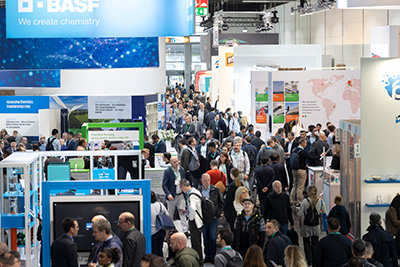| Plastics News |
BASF at K 2022: New low Product Carbon Footprint (PCF) portfolio presented in Düsseldorf
November 17, 2022 - BASF showcased a product portfolio of selected engineering plastics and polyurethanes with reduced carbon footprint (PCF) at the K 2022 trade fair. This presentation includes a range of Ultramid A and B, Ultradur, Ultraform, Elastollan, Elastopir and Elastocool families. BASF says all these products have PCF reductions of at least 30% compared to similar standard products while maintaining identical chemical and physical properties. Some lowPCF products, such as isocyanates, have a CO2e footprint close to zero. “To shape a more sustainable future with plastics together with our customers and partners, we need improvements at all stages of the plastics cycle”, says Jürgen Becky, Senior Vice President, Performance Materials Europe, BASF. “The sustainable production of plastics also helps to achieve this. Here is where our new lowPCF product portfolio comes into play.” lowPCF product portfolio: Certified by REDcert2 and available short term All products currently available from the lowPCF portfolio are certified according to the mass balance approach in line with the REDcert2 standard. The chemical and physical properties are identical to conventional products. Due to the already completed certification, the lowPCF products are available for the European market at short notice and within the usual delivery times. Many options, one target: lowPCF From the start, the new BASF lowPCF portfolio comprises various product families of engineering plastics and polyurethanes. This product diversity means there is no standard way to reduce emissions. Instead, the assessment of each product uses a different approach to determine where significant CO2e savings is possible during production. However, BASF says, all lowPCF products have one feature in common: the use of certified renewable feedstock. Biomethane or bionaphtha replace the conventional fossil raw materials at the beginning of the production process and are allocated to the respective lowPCF product using the mass balance approach. “In addition, green electricity is used in the production of lowPCF products at those sites, where it is available,” says Dr. Gregor Daun, Strategy Carbon Management, BASF. “The use of glass fibers and other additives with a reduced CO2e footprint is in preparation and will further improve the PCF of the products in the future.” Today, the lowPCF portfolio includes 18 products. At K 2022, customers could interactively explore the advantages and application diversity of these products with reduced greenhouse gas emissions at the BASF booth. The company says this portfolio will expand and become available worldwide in the mid-term based on customer demand; the next wave of products will be in 2023. Ultramid Advanced lowPCF products will then be available. The lowPCF product portfolio is part of the BASF measures to reduce greenhouse gas emissions in the value chains. An essential requirement for achieving this is the transparency of the carbon footprint at the product level. The PCF measures the climate impact of a product and considers total greenhouse gas emissions caused by a product in the different phases of its life cycle. To efficiently calculate product-related cradle-to-gate carbon footprints based on primary data, BASF developed SCOTT, a dedicated digital solution. It enables the company to provide accurate and detailed product-specific data on greenhouse gas emissions. .Source: BASF
|


